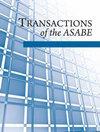A Proposed Method for Quantifying Thermal Exposure Incurred during Rough-Rice Drying
IF 1.4
4区 农林科学
Q3 AGRICULTURAL ENGINEERING
引用次数: 2
Abstract
HighlightsDrying conditions affect rice end-use functionality.Thermal exposure incurred by rough rice may differ depending on drying conditions.A framework is proposed for deriving an index that can show how much heat exposure rough rice incurs during drying.Abstract. Heated air is used to dry most rice in the U.S. Thus, commercial rice drying can be considered a thermal process that aims to remove moisture from rough rice until a desired moisture content is reached. Parallels can be drawn between rice drying and thermal sterilization that is targeted at reducing microbial load because moisture content reduction during drying follows similar decay rate kinetics as the reduction in microbial load during thermal sterilization. Given the different combinations of drying air conditions (air temperature and relative humidity), as well as drying and tempering durations, employed in various dryer designs for rice drying and the impact that these conditions have on rice end-use functionality, this study sought to derive a thermal treatment index (drying process values) that is similar to the F0 value concept used in thermal sterilization for quantifying and comparing the thermal exposure incurred by rice during drying under various scenarios. Using data collected from rough-rice drying experiments, a decimal desorption value (Dmv) that represents the duration required to cause a 90% reduction in moisture ratio during drying at a specified temperature was determined, from which a thermal desorption constant (Zmv) that represents the increase in temperature necessary to cause a 90% reduction in Dmv during drying was established. Subsequently, a thermal desorption value (Fmv) was derived to express the duration that a rice lot would have been heat treated at a reference temperature during drying to produce an equivalent effect on moisture content as that produced by the actual drying process. Keywords: End use, Moisture content, Peak viscosity, Postharvest, Relative humidity, Rice, Temperature.一种量化粗米干燥过程中热暴露的方法
干燥条件影响大米的最终用途。粗米的热暴露可能因干燥条件的不同而不同。提出了一个框架来推导一个指数,该指数可以显示糙米在干燥过程中产生的热量暴露。在美国,大多数大米都是用加热空气来干燥的。因此,商业大米干燥可以被认为是一个热过程,目的是去除大米中的水分,直到达到所需的水分含量。在大米干燥和旨在减少微生物负荷的热灭菌之间可以得出相似之处,因为干燥过程中水分含量的减少遵循与热灭菌过程中微生物负荷减少相似的衰减速率动力学。考虑到干燥空气条件(空气温度和相对湿度)的不同组合,以及干燥和回火时间,用于各种大米干燥机设计,以及这些条件对大米最终用途功能的影响,本研究试图得出一个热处理指数(干燥过程值),该指数类似于热灭菌中使用的F0值概念,用于量化和比较大米在各种情况下干燥过程中产生的热暴露。利用从粗米干燥实验中收集的数据,确定了十进制解吸值(Dmv),该值表示在特定温度下干燥过程中导致水分比降低90%所需的持续时间,并由此建立了热解吸常数(Zmv),该常数表示在干燥过程中导致Dmv降低90%所需的温度升高。随后,导出了热解吸值(Fmv),以表示在干燥过程中在参考温度下对大米进行热处理以产生与实际干燥过程产生的水分含量相当的效果的持续时间。关键词:最终用途,水分含量,峰值粘度,采后,相对湿度,大米,温度。
本文章由计算机程序翻译,如有差异,请以英文原文为准。
求助全文
约1分钟内获得全文
求助全文
来源期刊

Transactions of the ASABE
AGRICULTURAL ENGINEERING-
CiteScore
2.30
自引率
0.00%
发文量
0
审稿时长
6 months
期刊介绍:
This peer-reviewed journal publishes research that advances the engineering of agricultural, food, and biological systems. Submissions must include original data, analysis or design, or synthesis of existing information; research information for the improvement of education, design, construction, or manufacturing practice; or significant and convincing evidence that confirms and strengthens the findings of others or that revises ideas or challenges accepted theory.
 求助内容:
求助内容: 应助结果提醒方式:
应助结果提醒方式:


